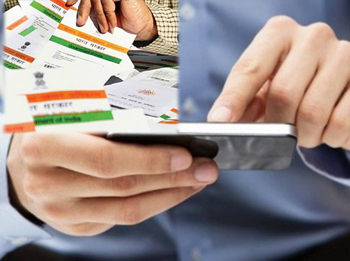Mar 27: All existing subscribers of mobile services will have to go for Aadhaar-based re-verification soon, with the government instructing telecom operators to initiate the process.
 Cellular operators' body COAI said its members may meet this week to discuss the modalities of rolling out the verification process for the existing one billion-plus mobile phone users.
Cellular operators' body COAI said its members may meet this week to discuss the modalities of rolling out the verification process for the existing one billion-plus mobile phone users.
"...all licensees shall re-verify all existing mobile subscribers (prepaid and postpaid) through Aadhaar-based eKYC process...," a notification issued by the telecom department said.
It further added that all licensees will have to inform existing subscribers - through advertisements in print and electronic media as well as SMS - about the order of the Supreme Court for re-verification activity. They have also been asked to upload the details of the exercise on their website.
The Supreme Court, in an order in February this year, had observed that, "an effective process has been evolved to ensure the identity verification, as well as, the addresses of all mobile phone subscribers for the new subscribers. In the near future, and more particularly within one year from today, a similar verification will be completed, in case of existing subscribers".
The telecom department has said the operators will use and share common device eco-system through mutual agreements, and will work out mechanisms to avoid public inconvenience and long queues.
When contacted, cellular operators association COAI said that the industry supported the move, but pointed out that the entire exercise will cost Rs. 1,000 crores for infrastructure and training, which will have to be borne by the operators.
"The issue of fake subscribers will go away. We will try our best to cover the entire base within the stipulated time frame of one year but in case we cannot, we may ask DoT for an extension," COAI Director General Rajan Mathews said.
For re-verification through Aadhaar-based eKYC process, the operator will send a verification code to the mobile number of the subscriber. Prior to starting the eKYC, the operator will verify this code from the subscriber so as to confirm the SIM card of the mobile connection is physically available with the subscriber.
"After the completion of the eKYC process, before updating or overwriting the old subscriber detail in database with the data received through eKYC process, the licensee will seek confirmation from the subscriber about the re-verification of his/her mobile number after 24 hours through SMS," the notification said.
The operator can re-verify more than one mobile connection in one service area through a single eKYC but not bulk connections. For issuing additional mobile connections to re-verified subscriber, the operator would have to follow a separate eKYC process.
Verification of a subscriber would not be required in case of conversions - that is prepaid to postpaid connections or vice versa, it clarified.





Comments
Add new comment